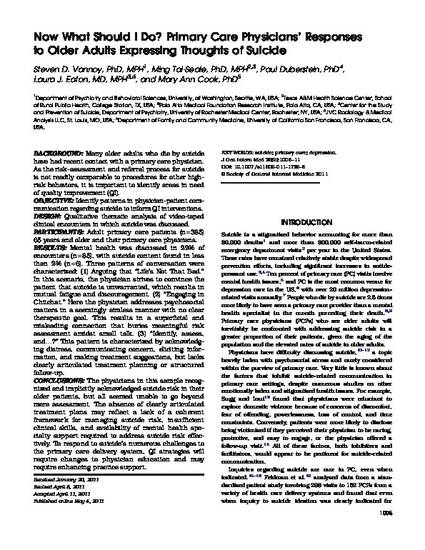
ACKGROUND: Many older adults who die by suicide have had recent contact with a primary care physician. As the risk-assessment and referral process for suicide is not readily comparable to procedures for other high- risk behaviors, it is important to identify areas in need of quality improvement (QI). OBJECTIVE: Identify patterns in physician-patient com- munication regarding suicide to inform QI interventions. DESIGN: Qualitative thematic analysis of video-taped clinical encounters in which suicide was discussed. PARTICIPANTS: Adult primary care patients (n=385) 65 years and older and their primary care physicians. RESULTS: Mental health was discussed in 22% of encounters (n=85), with suicide content found in less than 2% (n=6). Three patterns of conversation were characterized: (1) Arguing that “Life’s Not That Bad.” In this scenario, the physician strives to convince the patient that suicide is unwarranted, which results in mutual fatigue and discouragement. (2) “Engaging in Chitchat.” Here the physician addresses psychosocial matters in a seemingly aimless manner with no clear therapeutic goal. This results in a superficial and misleading connection that buries meaningful risk assessment amidst small talk. (3) “Identify, assess, and...?” This pattern is characterized by acknowledg- ing distress, communicating concern, eliciting infor- mation, and making treatment suggestions, but lacks clearly articulated treatment planning or structured follow-up. CONCLUSIONS: The physicians in this sample recog- nized and implicitly acknowledged suicide risk in their older patients, but all seemed unable to go beyond mere assessment. The absence of clearly articulated treatment plans may reflect a lack of a coherent framework for managing suicide risk, insufficient clinical skills, and availability of mental health specialty support required to address suicide risk effectively. To respond to suicide’s numerous challenges to the primary care delivery system, QI strategies will require changes to physician education and may require enhancing practice support.
- suicide; primary care; depression.
Available at: http://works.bepress.com/steven_vannoy/15/
